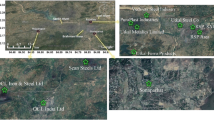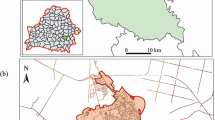Abstract
The objective of this study was to elaborate a series of mathematical models with the aim of short-term prediction of TSP, PM10, As, Cd, Ni and Pb in ambient air. These pollutants depend on some known variables (meteorological variables). The reason for choosing this pollutant type is that particulate matter may present a much higher potential risk despite its low representativeness as compared with the gas pollutant group. A positive correlation between high particle concentrations and deterioration in public health has been shown in recent studies. The elements As, Cd, Ni and Pb in PM10 were also analyzed to determine the toxicity of these particles. The goal is to provide a useful instrument to alert the population facing possible episodes of high concentrations of atmospheric pollutants. The study was carried out in a highly industrialized area in the ceramic cluster of Castellón for 5 years (2001–2005). The origin of the contamination in this area is both natural and anthropogenic. The natural origin is due to the resuspension of mineral materials from the surrounding mountains and from the long-range transport of materials from North Africa. The anthropogenic contamination sources that stand out include the non-metallic mineral material industries (ceramic production), chemical industries (color, frit and enamel manufacturing), as well as vehicular traffic. Once the particle samples were collected in quartz fiber filters, the concentration levels of TSP and PM10 were determined gravimetrically. The chemical analysis of the filters was carried out by ICP-MS. Predictive models have been constructed by using multiple regression analysis together with time series models (ARIMA). The SPSS 14.0 statistical software has been employed to analyze the obtained experimental data.








Similar content being viewed by others
References
Boix A, Jordán MM, Querol X, Sanfeliu T (2001) Characterization of total suspended particles around a power station in an urban coastal area in eastern Spain. Env Geol 40:891–896
Colombo JC, Landoni P, Bilos C (1999) Sources, distribution and variability of airborne particles and hydrocarbons in La Plata, Argentina. Environ Pollut 3:26–31
European Council Directive 1999/30/EC of 22 April 1999 relating to limit values for sulphur dioxide, nitrogen dioxide and oxides of nitrogen, particulate matter and lead in ambient air. Official Journal of the European Union L163, 26 Sept 1999, pp 41–60
European Council Directive 80/779/EEC of 15 July 1980 on air quality limit values and guide values for sulphur dioxide and suspended particulates. Official Journal of the European Union L229, 30 Aug 1980, pp 30–48
Fernández AJ, Ternero M, Barragán F, Jiménez C (2001) Size distribution of metals in urban aerosol in Seville (Spain). Atmos Environ 35:2595–2601
Gómez ET, Sanfeliu T, Jordán MM, Rius J, De la Fuente C (2004) Geochemical characteristics of particulate matter in the atmosphere surrounding ceramic industrialised area. Env Geol 45:536–543
Jordan MM, Almendro M, Romero M, Rincón JM (2005) Application of sewage sludge in the manufacturing of ceramic tile bodies. Appl Clay Sci 30(3–4):219–224
Kantarci MD, Karaöz O (2001) Air pollution effects on forests in Turkey. Fresenius Environ Bull 10(3):323–328
Kelessis AG (2001) Eleven years of primary air-pollutant observation in the city of Thessaloniki, Greece. Fresenius Environ Bull 10(7):624–628
Kubilay N, Saydam AC (1995) Trace elements in atmospheric particulate over the eastern Mediterranean; concentrations, sources and temporal variability. Atmos Environ 29:2289–2300
McGregor GR (1999) Basic Meteorology. In: Holgate ST, Samet JM, Maynard RL (eds) Air pollution and health. Academic Press, San Diego, pp 21–49
McMichael AJ, Woodruff RE, Hales S (2006) Climate change and human health; present and future risk. Lancet 367:859–869
Pallarés S, Vicente AB, Jordán MM, Sanfeliu T (2007) Study of the levels of concentrations of As, Cd and Ni in a ceramic cluster. Water Air Soil Pollut 180:51–64
Pérez C, Nickovic S, Baldasano JM, Sicard M, Rocadenbosch R (2006) A long Saharan dust event over the western Mediterranean: Lidar sun photometer observations, and regional dust modeling. J Geophys Res 111:D15214. doi:10.1029/2055JD006579
Querol X, Alastuey A, López-Soler A, Plana F (2000) Levels and chemistry of atmospheric particulates induced by spill of heavy metal mining wastes in the Doñana area, Southwest Spain. Atmos Environ 34:239–253
Rencher AC (2000) Linear models in statistics. Wiley, New York, pp 121–153, 214–222
Rodríguez S, Querol X, Alastuey A, Kallos G, Kakaliagaou O (2001) Saharan dust contribution to PM10 and TPS levels in southern and eastern Spain. Atmos Environ 32:2433–2447
Röösli M, Theis G, Künzli N, Staenhelin J, Mathys P, Osglesby L, Camenzind M, Braun-Fahrländer Ch (2000) Temporal and spatial variation of the chemical composition of PM10 at urban and rural site in the Basel area, Switzerland. Atmos Environ 35:3701–3713
Sanfeliu T, Jordán MM, Gómez ET, Álvarez C, Montero MA (2002) Contribution of the atmospheric emissions of Spanish ceramic industries. Env Geol 41:601–607
Sivakumar MVK (2006) Interactions between climate and desertification. Agric For Meteorol. doi:10.1016/j.agrfomet.2066.0.3.025
UNE-EN 12341:1999 Air quality: determination of the PM10 fraction of the suspended particulate matter. Reference method and field test procedure to demonstrate reference equivalence of measurement methods
Vicente AB, Jordan MM, Pallarés S, Sanfeliu T (2007) PM10 and Pb evolution in an industrial area of the Mediterranean basin. Env Geol 51:1413–1424
Wark K, Warner CF (2000) Air pollution. Its origin and control. Harper & Row Publisher, Balderas, pp 99–137
Wei WWS (1990) Time series analysis. Univariate and multivariate methods. Addison-Wesley, California, pp 32–154
Author information
Authors and Affiliations
Corresponding author
Rights and permissions
About this article
Cite this article
Vicente, A.B., Jordán, M.M., Sanfeliu, T. et al. Air pollution prediction models of particles, As, Cd, Ni and Pb in a highly industrialized area in Castellón (NE, Spain). Environ Earth Sci 66, 879–888 (2012). https://doi.org/10.1007/s12665-011-1298-z
Received:
Accepted:
Published:
Issue Date:
DOI: https://doi.org/10.1007/s12665-011-1298-z




